
Same Athletes, Same Result For LSU At NCAAs
Winning both relays in the same NCAA Division I Outdoor Track & Field Championships had only been done twice by men’s programs before 2003 at Hornet Stadium in Sacramento, California.
LSU became the third with a unique twist – both squads were made up of the same four athletes. In fact, it has only happened one other time in meet history: Florida State’s women did the same in 1983.
The Tiger men didn’t enter the NCAA meet favored in either relay, but by the time of the first final – Friday’s 4×100 – LSU had broken 39 seconds for the first time with a nation-leading 38.84 in the heats. That was just inches ahead of SEC champ Tennessee’s 38.85.
In the final, LSU again had their best race all year as the foursome of Kelly Willie, Robert Parham, Pete Coley and Bennie Brazell improved to 38.65. Brazell held off UT’s Jonathan Wade on the homestretch as the Volunteers also ran a seasonal best of 38.72.
As is just about normal in the NCAA meet, the concluding track event on Saturday provided four laps of excitement. LSU had won the NCAA Indoor 4×400 crown in March, but outdoors had yet to better their 3:04.79 indoor time and was actually just the final qualifier for this final.
Baylor had the fastest seasonal best of the finalists at 3:02.82, but the fashionable pick was Minnesota. The Golden Gophers were led by Adam Steele and Mitch Potter, who earlier in the afternoon finished a surprising 1-3 in the 400.
At the first exchange, Minnesota’s Steele (45.8) handed off just behind Texas, which had the fastest split at 45.7. Robert Parham (who owned a 20.44 PR in the 200) kept LSU close with a 46.4 split as all eight teams were in contention.
Minnesota got a strong second leg from Andy Wohlin (45.9) to take the lead as Baylor was now in second. LSU moved into third with a 45.9 split by Brazell, who had finished fourth in 400 hurdles the previous day after his anchor duties on the 4×100.
LSU took the lead on the third leg after a 45.1 split from Coley, who showed some of his form from 2002 when he ran 44.89 and was third in the NCAA 400. Minnesota remained in second just ahead of fast-moving Texas Tech after a storming 44.5 split from Julian Raeborn.
The anchor legs were fast with a thrilling homestretch battle between the Gophers’ Potter and the Tigers’ Willie, who was fifth earlier in the 400. Willie never relinquished the lead, splitting 44.6 to hold off the 44.5 of Potter.
The squads from LSU (first in 3:02.01) and Minnesota (second in a school-record 3:02.33) recorded their best-ever finishes in the event.
The Tigers would see additional NCAA scoring from Brazell and Willie. Brazell was second in the 400 hurdles in 2004 and 2005, while Willie was runner-up in the 400 in 2004 and 200 in 2006. Both were staples on both relay teams, including a 2:59.59 in 2005 that was the collegiate record for 13 years.
Brazell, who was also a wide receiver on LSU’s 2003 national-champion football team, is now in his 10th year as an assistant coach on the Tiger track & field program.
The NCAA and collegiate track & field will mark a momentous milestone in the spring of 2021 -- the 100th anniversary of the NCAA Championships and with that, the NCAA Track & Field Championships. In June 1921, the University of Chicago hosted the first track & field championships in NCAA history.
This point can’t be emphasized enough: Not only was the event the first for NCAA track & field, but the first championships for any sport under the sponsorship of the NCAA.
To celebrate, over each of the next 365 days, the U.S. Track & Field and Cross Country Coaches Association (USTFCCCA) will celebrate moments, student-athletes, and coaches that have made a century’s worth of championships special. From humble beginnings to important historical milestones to the modern-day, collegiate track & field has evolved with the American society.
The 2021 edition of the NCAA Division I Outdoor Track & Field Championships begin with preliminary round action on May 27-29 in Jacksonville, Fla., and College Station, Texas. The championships final site and culmination of the celebration is slated for June 9-12, 2021 at the newly rebuilt Hayward Field in Eugene, Ore.
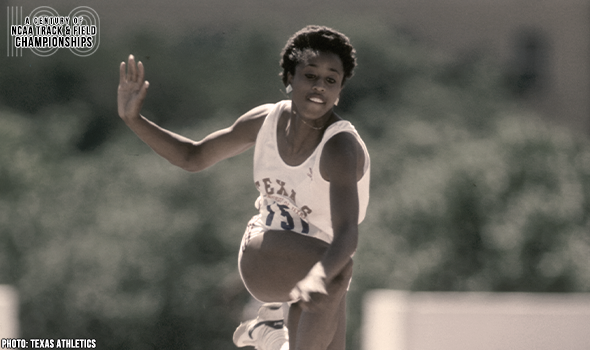
Texas’ Turner Soared To Triple Jump Greatness
Terri Turner was a two-time TJ champion at the NCAA DI Outdoor T&F Championships. When Turner won her 2nd title in 1986, she set an all-time world best of 13.66m (44-9¾).
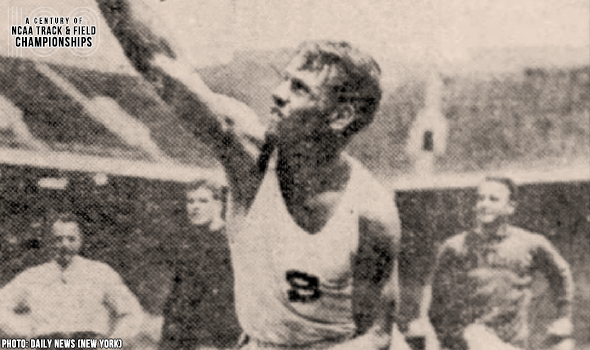
Stanford’s Rothert Starred In The Shot Put
Harlow Rothert won three consecutive shot put titles at the NCAA Outdoor T&F Championships between 1928 & 1930. He set meet records in both 1929 and 1930.

Indiana’s Kharun Set Javelin MR In 2003
Irina Kharun won the javelin title at the 2003 NCAA DI Outdoor T&F Championships with a meet record heave of 61.82m (202-10). It also helped her win by more than 30 feet!
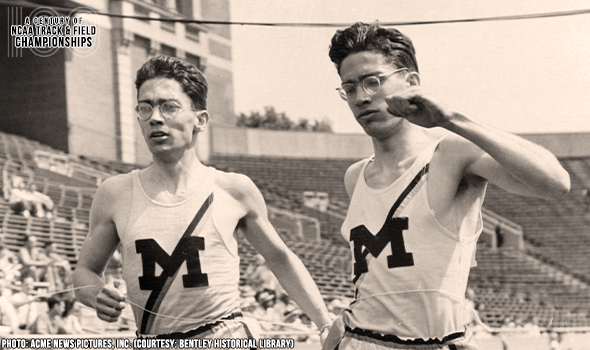
Hume Brothers Had Officials Seeing Double
Twins Robert & Ross Hume purposefully tied for the mile crown at the 1944 NCAA Outdoor Track & Field Championships. They tried again in 1945, but officials gave Ross the win.
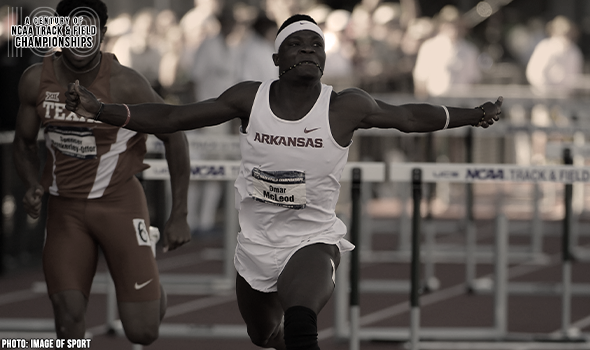
Woo Pig Sooie! McLeod Sizzled Track In 2015!
Omar McLeod clocked a sizzling 13.01 (+3.9) to win the 110HH at the 2015 NCAA DI Outdoor T&F Championships. Only one man had ever gone faster in meet history at the time.

Felicien Starred In The 100H At NCAAs
Perdita Felicien won back-to-back 100H titles at the NCAA Division I Outdoor T&F Championships in 2002 & 2003. She set a MR of 12.68 in the semifinals on the way to title No. 2.

Truly “Unbroken,” Zamperini Shined At NCAAs
Louis Zamperini set a meet record in the mile of 4:08.3 at the 1938 NCAA Outdoor T&F Championships. Zamperini, who also won the mile in 1939, saw his record last 15 years.
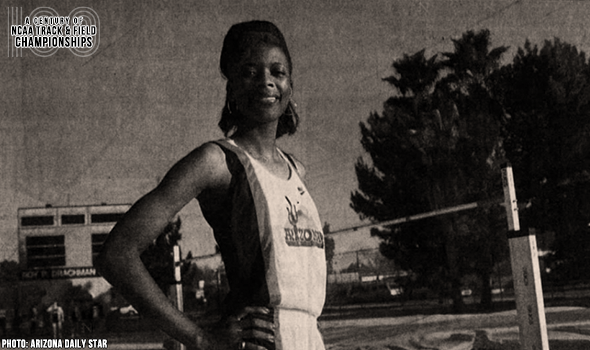
Hughes Soared To Three Consecutive HJ Titles
Tanya Hughes was the first woman to win three high jump titles at the NCAA Division I Outdoor T&F Championships. Hughes did so consecutively in 1991, 1992 & 1993.
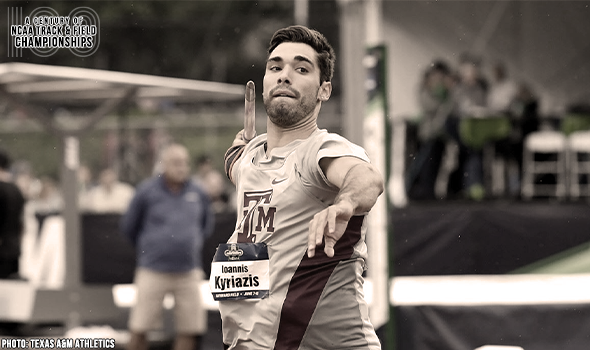
Kyriazis Made Point With Javelin In 2017
Ioannis Kyriazis set a meet record in the javelin of 82.58m (270-11) and won by more than 19 feet at the 2017 NCAA DI Outdoor T&F Championships.
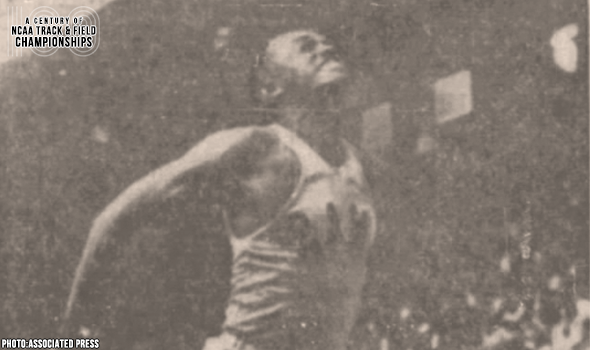
Sharpe Bounded To Meet History In 1956
Bill Sharpe became the first man to eclipse the 50-foot barrier in the triple jump at the NCAA DI Outdoor T&F Championships in 1956. Sharpe won with his 15.36m (50‑4¾) effort.

